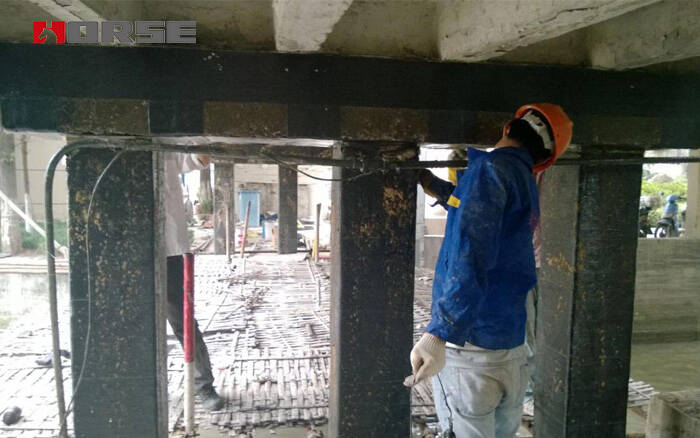Solutions
Horse Construction offers full range of structural strengthening materials with technical supports, documentation supports, products supports, project supports.
The Pros and Cons of Carbon Fiber Reinforced Concrete Bridges

The principles, technical characteristics, reinforcement methods and reinforcement effects of carbon fiber reinforced concrete structures are explained, and the advantages and disadvantages of carbon fiber cloth reinforced concrete beam bridges are pointed out, which provides a reference for the reinforcement of concrete beam bridges in the future.
The principle of carbon fiber reinforced concrete structure
When a special resin is used to paste carbon fiber on the tensile surface of a concrete structure, the carbon fiber and the original structure form a new force. The overall carbon fiber and steel bar can bear the load, reducing the stress of the steel bar, so that the structure can achieve the effect of reinforcement and reinforcement.
Carbon fiber composite materials are widely used in bridge reinforcement. As a commonly used reinforcement material, carbon fiber has much stronger corrosion resistance than conventional reinforcement materials (such as steel plates). The structures in the corrosive environment and the concrete structures along the coast are mostly corroded by the external environment, resulting in structural deterioration. Wrapping carbon fiber on the outside of the structural member can effectively use its stability and its insensitivity to acid, alkali and temperature difference to protect the structure itself, reduce damage, enhance the durability of the structure, and prolong its service life. However, the shear resistance of carbon fiber is insufficient, and its use in the shear resistance part of the bridge structure does not have any effect. Improper handling will also fail when bonding with old concrete; water intrusion in the beam will also affect the effect of carbon fiber.
The main features of the pasted carbon fiber reinforcement technology:
Almost no increase in structural weight and cross-sectional dimensions;
Do not change the clearance height under the bridge;
Convenient construction;
Hardly cause new damage to the original structure;
Has good corrosion resistance, durability and fatigue resistance;
Excellent mechanical properties
It can be effectively applied to a variety of structural reinforcement. Including bending resistance, shear resistance, compression resistance, fatigue resistance, earthquake resistance, wind resistance, expansion of cracks and deflection, and increased ductility of the structure, multi-layer paste reinforcement can be carried out according to force analysis, and its directionality can also be flexibly controlled.
In addition, the carbon fiber is soft in texture, which can reinforce various concrete structures without changing the shape of the structure. After reinforcement, it can be coated with concrete mortar, or the pattern requires various paints to repair and strengthen without leaving traces.
Reinforcing method with carbon fiber cloth:
Flexural reinforcement, the carbon fiber sheet is attached to the side under tension;
Shear reinforcement, pasted vertically on both sides of the beam, or formed a U-shaped loop on the bottom surface, which is equivalent to adding shear stirrups;
Anti-crack reinforcement, paste along the vertical direction of the crack;
The columnar center compression member is reinforced, and the column center ring is attached;
For shear wall reinforcement, carbon fiber sheets are pasted along the direction of shear reinforcement on one or both sides of the shear wall.
The effect of carbon fiber reinforcement is significant, but the following issues should be paid attention to in the actual bridge reinforcement project: The use environment and construction conditions of carbon fiber are very different from those in the laboratory. In addition, the construction performance of the material itself affects the construction quality. Therefore, the design tensile strength of carbon fiber should be considerably reduced from the laboratory data. The process level of the construction team is also a factor that affects the mechanical properties of composite materials, but it is not yet possible to conduct a quantitative evaluation. At present, it is scientific and reasonable to use the sub-factor method to define the influencing factors that affect the design strength of carbon fiber during the use of carbon fiber. However, the specific values of these coefficients should be determined based on a large number of experimental values and scientific theoretical analysis.
You can find anything here you are in need of, have a trust trying on these products, you will find the big difference after that.

High strength carbon fiber reinforced polymer (CFRP) strip / laminate / plate for structural strengthening and concrete repair

Prestressed carbon fiber reinforced polymer(CFRP) plate for slab, beam strengthening to increase stiffness, reduce distortion and deflection of members, reduce the cracks, avoid and stop cracking.

High strength, unidirectional carbon fiber sheet pre-saturated to form a carbon fiber reinforced polymer (CFRP) sheet used to strengthen structural concrete elements.